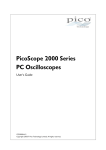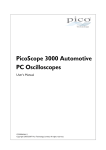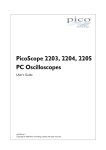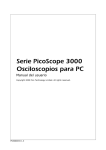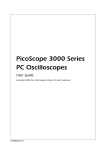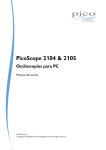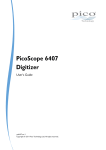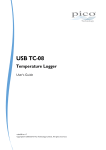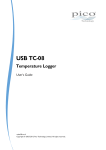Download PicoScope 2000 Series User Guide
Transcript
PicoScope 2000 Series PC Oscilloscopes User guide Copyright 2005 Pico Technology Limited. All rights reserved. PS2000044-1.0 I PicoScope 2000 Series User Guide Table of Contents 1 Introduction .............................................................................................2 1 Overview ...................................................................................................2 ...................................................................................................2 2 Safety symbols ...................................................................................................3 3 Safety warning 4 FCC notice...................................................................................................3 5 CE notice ...................................................................................................4 ...................................................................................................4 6 Licence conditions ...................................................................................................4 7 Trademarks 8 Warranty ...................................................................................................5 9 Company ...................................................................................................5 details .............................................................................................6 2 Product information 1 Minimum ...................................................................................................6 system requirements ...................................................................................................7 2 Installation instructions ...................................................................................................8 3 Specifications 4 Sampling ...................................................................................................8 modes 3 Glossary Index .............................................................................................9 ......................................................................................................11 Copyright 2005 Pico Technology Limited. All rights reserved. Introduction 1 Introduction 1.1 Overview 2 The PicoScope 2000 series is a range of low-cost, high-performance PC Oscilloscopes, fully USB 2.0 capable and backwards compatible with USB 1.1. There is no need for an additional power supply as power input is from the USB port, so these oscilloscopes are highly portable. With the PicoScope software, you can use PicoScope 2000 series oscilloscopes as PC Oscilloscopes and spectrum analysers; with the PicoLog software, you can use them as data loggers. A PicoScope 2000 PC Oscilloscope is supplied with the following items: USB cable, for use with both types of USB port Software CD Quick start guide Please read the important information in this introductory section and then proceed to the Installation instructions. 1.2 Safety symbols Symbol 1: Warning Triangle This symbol indicates that a safety hazard exists on the indicated connections if correct precautions are not taken. Ensure that you read all safety documentation associated with the product before using it. Symbol 2: Equipotential This symbol indicates that the outer shells of the indicated BNC connectors are all at the same potential (shorted together). You must therefore take necessary precautions to avoid applying a potential across the return connections of the indicated BNC terminals, as this may result in a large current flow causing damage to the product and/or connected equipment. Copyright 2005 Pico Technology Limited. All rights reserved. PS2000044-1.0 3 1.3 PicoScope 2000 Series User Guide Safety warning We strongly recommend that you read the general safety information below before using your oscilloscope for the first time. Safety protection built in to the equipment may cease to function if the equipment is used incorrectly. This could cause damage to your computer, or lead to injury to yourself and others. Maximum input range PicoScope 2000 Series PC Oscilloscopes are designed to measure voltages in the range -20 V to +20 V. Any voltages in excess of ±100 V may cause physical damage. Mains voltages Pico Technology products are not designed for use with mains voltages. To measure mains, use a differential isolating probe specifically designed for a high source voltage. Safety grounding PicoScope 2000 Series PC Oscilloscopes connect directly to the ground of a computer through the interconnecting cable provided. This method minimises interference. As with most oscilloscopes, avoid connecting the ground input to any source other than ground. If in doubt, use a meter to check that there is no significant AC or DC voltage between the ground input of the oscilloscope and the point to which you intend to connect it. Failure to check may cause damage to your computer, or lead to injury to yourself and others. You should assume that the product does not have a protective safety earth. Repairs The oscilloscope contains no serviceable parts. Repair or calibration of the oscilloscope requires specialised test equipment and must be performed only by Pico Technology. 1.4 FCC notice This equipment has been tested and found to comply with the limits for a Class A digital device, pursuant to Part 15 of the FCC Rules. These limits are designed to provide reasonable protection against harmful interference when the equipment is operated in a commercial environment. This equipment generates, uses, and can radiate radio frequency energy and, if not installed and used in accordance with the instruction manual, may cause harmful interference to radio communications. Operation of this equipment in a residential area is likely to cause harmful interference in which case the user will be required to correct the interference at his own expense. For safety and maintenance information see the safety warning. PS2000044-1.0 Copyright 2005 Pico Technology Limited. All rights reserved. Introduction 1.5 4 CE notice The PicoScope 2000 Series of PC Oscilloscopes meets the intent of the EMC directive 89/336/EEC and has been designed to EN61326-1 (1997) Class B Emissions and Immunity standard. Products from the PicoScope 2000 series also meet the intent of the Low Voltage Directive and have been designed to meet the BS EN 61010-1:2001 IEC 61010-1:2001 (safety requirements for electrical equipment, control, and laboratory use) standard. 1.6 Licence conditions The material contained in this release is licensed, not sold. Pico Technology Limited grants a licence to the person who installs this software, subject to the conditions listed below. Access The licensee agrees to allow access to this software only to persons who have been informed of these conditions and agree to abide by them. Usage The software in this release is for use only with Pico products or with data collected using Pico products. Copyright Pico Technology Limited claims the copyright of, and retains the rights to, all material (software, documents etc.) contained in this release. You may copy and distribute the entire release in its original state, but must not copy individual items within the release other than for backup purposes. Liability Pico Technology and its agents shall not be liable for any loss, damage or injury, howsoever caused, related to the use of Pico Technology equipment or software, unless excluded by statute. Fitness for purpose Because no two applications are the same, Pico Technology cannot guarantee that its equipment or software is suitable for a given application. It is your responsibility, therefore, to ensure that the product is suitable for your application. Mission-critical applications This software is intended for use on a computer that may be running other software products. For this reason, one of the conditions of the licence is that it excludes usage in mission-critical applications; for example, life-support systems. 1.7 Trademarks Windows and Excel are registered trademarks or trademarks of Microsoft Corporation in the USA and other countries. Pico Technology Limited, PicoLog and PicoScope are trademarks of Pico Technology Limited, registered in the United Kingdom and other countries. Copyright 2005 Pico Technology Limited. All rights reserved. PS2000044-1.0 5 1.8 PicoScope 2000 Series User Guide Warranty Pico Technology warrants upon delivery, and for a period of 24 months unless otherwise stated from the date of delivery, that the Goods will be free from defects in material and workmanship. Pico Technology shall not be liable for a breach of the warranty if the defect has been caused by fair wear and tear, wilful damage, negligence, abnormal working conditions or failure to follow Pico Technology's spoken or written advice on the storage, installation, commissioning, use or maintenance of the Goods or (if no advice has been given) good trade practice; or if the Customer alters or repairs such Goods without the written consent of Pico Technology. 1.9 Company details Address: Pico Technology Limited The Mill House Cambridge Street St Neots Cambridgeshire PE19 1QB United Kingdom Phone: +44 (0) 1480 396 395 Fax: +44 (0) 1480 396 296 Email: Technical Support [email protected] Sales [email protected] Web site: www.picotech.com PS2000044-1.0 Copyright 2005 Pico Technology Limited. All rights reserved. Product information 2 Product information 2.1 Minimum system requirements 6 For PicoScope 2000 series PC Oscilloscopes to operate, a computer with the minimum system requirements to run Windows or the following (whichever is the higher specification) is required: Processor Pentium class processor or equivalent minimum. Memory 32 MB minimum. Disk space 10 MB minimum. Operating system Microsoft Windows 98 SE, ME, Microsoft Windows 2000, XP or later. Ports USB 1.1 compliant port minimum. USB 2.0 compliant port recommended. Must be connected direct to the port or a powered USB hub. Will not work on a passive hub. Copyright 2005 Pico Technology Limited. All rights reserved. PS2000044-1.0 PicoScope 2000 Series User Guide 7 2.2 Installation instructions Important Do not connect a PicoScope 2000 series PC Oscilloscope to the PC until you have installed the software. Install the software by following the steps in the installation guide supplied with your oscilloscope. Connect your oscilloscope to the PC with the USB cable supplied. There is no need for an additional power supply as power is drawn from the USB port. Checking the installation Once the software has been installed, ensure that the oscilloscope is connected to the PC and start the PicoScope or PicoLog software. The software should now display the voltage that you have connected. If you are using a scope probe and PicoScope, you should see a small 50 Hz or 60 Hz mains signal in the oscilloscope window when you touch the scope probe tip with your finger. Standard oscilloscope connectors PicoScope 2000 series PC Oscilloscopes have standard oscilloscope connectors. The input impedance is also standard, so the x10 function on scope probes works correctly. Connector diagram 1 2 A B USB port connector. LED. When lit, indicates the oscilloscope is sampling data. Channel A input. Channel B input. PS2000044-1.0 Copyright 2005 Pico Technology Limited. All rights reserved. Product information 2.3 8 Specifications PicoScope 2202 Vertical Resolution 8 bits Analog Bandwidth 2 MHz Maximum Sampling Rate Single-channel Dual-channel Buffer Size Single-channel Dual-channel Inputs Voltage Ranges Accuracy Operating Environment Temperature range Humidity 20 MS/s 10 MS/s 32 ksamples 16 ksamples 2 channels with BNC sockets 1 MW impedance AC/DC coupling 20 pF input capacitance ± 50 mV to ± 20 V ranges in 1, 2, 5 steps 3 % (voltage) 100 ppm (time) 0°C to 70°C (20°C to 30°C for quoted accuracy) 25% to 75% RH ± 100 V Overload Protection 2.4 PC Connection USB 2.0 Compatible with USB 1.1 Power Supply From USB port: 4.6 to 5.25 V; 500 mA External power supply is not required Maximum Dimensions 140 mm x 190 mm x 45 mm Compliance CE standard; FCC standard Sampling modes PicoScope 2000 series PC Oscilloscopes can run in various sampling modes. At high sampling rates, the oscilloscope collects data much faster than a PC can read it. To compensate for this, the oscilloscope stores a block of data in an internal memory buffer, delaying transfer to the PC until a preset number of data points has been sampled. This is called block mode. At very low sampling rates, you may want to switch to streaming mode. This allows accurately timed data to be transferred back to the PC in short blocks, without gaps. Real time continuous mode is also provided for use at low sampling rates, when immediate data transfer without gaps is required but timing accuracy is not critical. Copyright 2005 Pico Technology Limited. All rights reserved. PS2000044-1.0 9 3 PicoScope 2000 Series User Guide Glossary AC/DC switch To switch from alternating current to direct current, or vice versa, select AC or DC from the control on the oscilloscope toolbar of the PicoScope software application. The setting should be adjusted to suit the characteristics of the input signal. Analog bandwidth The input frequency at which the signal amplitude has fallen by 3 dB from its nominal value. Block mode A sampling mode in which the computer prompts the oscilloscope to collect a block of data into its internal memory before stopping the oscilloscope and transferring the whole block into computer memory. This mode of operation is suitable when the input signal being sampled contains high frequencies. Note: To avoid aliasing effects, the sampling rate must be greater than twice the maximum input frequency. Buffer size The size of the oscilloscope buffer memory. The buffer memory is used by the oscilloscope to store data temporarily. This allows the oscilloscope to sample data independently of the speed at which it can transfer data to the computer. Device Manager Device Manager is a Windows applet that displays the current hardware configuration of your computer. On Windows 98 or Windows ME, right click on 'My Computer' and choose the 'Device Manager' tab. On Windows 2000 or Windows XP, right click on 'My Computer,' choose the 'Hardware' tab and select 'Device Manager'. Driver A software application that controls a piece of hardware. The driver for the PicoScope 2000 series PC Oscilloscopes is supplied in the form of a 32 bit Windows DLL. This is used by the PicoScope and PicoLog software to control the oscilloscopes. Maximum sampling rate A figure indicating the maximum number of samples the oscilloscope is capable of acquiring per second. Maximum sample rates are usually given in MS/s (megasamples per second) or GS/s (gigasamples per second.) The higher the sampling speed of the oscilloscope, the more accurate the representation of the high-frequency details in a fast signal. PC Oscilloscope An instrument consisting of a PicoScope 2000 series PC Oscilloscope and the PicoScope software application. PicoLog software This is a software product that accompanies all our oscilloscopes. It turns your PC into a data logger and chart recorder. PicoScope 2000 series A PC Oscilloscope range that includes the PicoScope 2202 PC Oscilloscope. PicoScope software This is a software product that accompanies all our oscilloscopes. It turns your PC into an oscilloscope, spectrum analyser, and meter display. PS2000044-1.0 Copyright 2005 Pico Technology Limited. All rights reserved. Glossary 10 Real time continuous mode A sampling mode in which the software repeatedly requests single samples from the oscilloscope. This mode is suitable for low sampling rates when you require the latest sample to be displayed as soon as it is captured. Streaming mode A sampling mode in which the oscilloscope samples data and returns it to the computer in an unbroken stream. This mode of operation is suitable when the input signal being sampled contains only low frequencies. Timebase The timebase controls the time interval that the width of the scope display represents. If you select Timebase is time per division in the Preferences dialog box in the PicoScope application, it works like a traditional bench top scope. There are ten divisions across the screen, so the total time interval is ten times the timebase. USB 1.1 Universal Serial Bus (Full Speed). This is a standard port that enables you to connect external devices to PCs. A typical USB 1.1 port supports a data transfer rate of 12 Mbps (12 megabits per second), and is much faster than a serial port. USB 2.0 Universal Serial Bus (High Speed). This is a standard port that enables you to connect external devices to PCs. A typical USB 2.0 port supports a data transfer rate that is 40 times faster than that supported by USB 1.1. An additional feature of USB 2.0 is that it is backwards compatible with USB 1.1. Vertical resolution A value, in bits, related to the number of distinct input voltage levels that the oscilloscope can convert to digital values. Calculation techniques can improve the effective resolution. Voltage range The range of input voltages that the oscilloscope will measure in a given mode. Copyright 2005 Pico Technology Limited. All rights reserved. PS2000044-1.0 11 PicoScope 2000 Series User Guide PicoScope 2000 series 2, 3, 4, 6, 7 PicoScope software 2, 7 Power supply 8 Probe (oscilloscope) 7 Index A Accuracy 8 Analog bandwidth R Repair 8 S B BNC connector Buffer size 8 Safety symbols 2 Safety warning 3 Sampling rate (maximum) Scope probe 7 Spectrum analyser 2 System requirements 6 7 C Calibration 3 Contact details 5 Data logger Dimensions 8 T D Temperature 8 Test equipment 3 2 8 U H Humidity 3 USB 2, 6 USB 1.1 6 USB 2.0 6 8 I V Input range (maximum) Inputs 8 8 Vertical resolution 8 Voltage ranges 8 M Maximum input range 3 O Operating environment Oscilloscope probe 7 Overload protection 8 8 P PC connection 8 PC oscilloscopes 2, 4 PicoLog software 2 Copyright 2005 Pico Technology Limited. All rights reserved. Pico Technology Ltd The Mill House Cambridge Street St Neots PE19 1QB United Kingdom Tel: +44 (0) 1480 396 395 Fax: +44 (0) 1480 396 296 Web: www.picotech.com PS2000044-1.0 7.6.05













